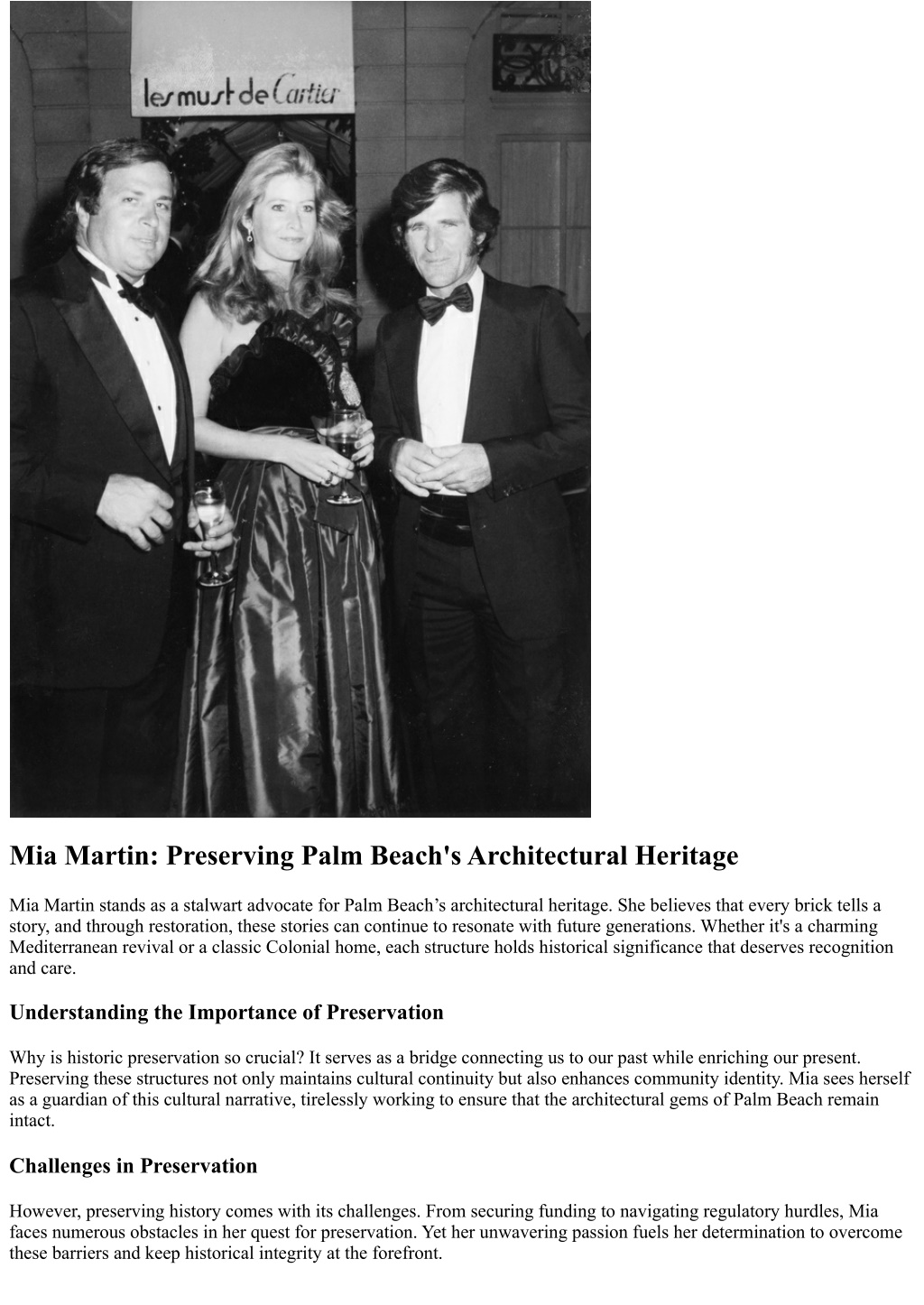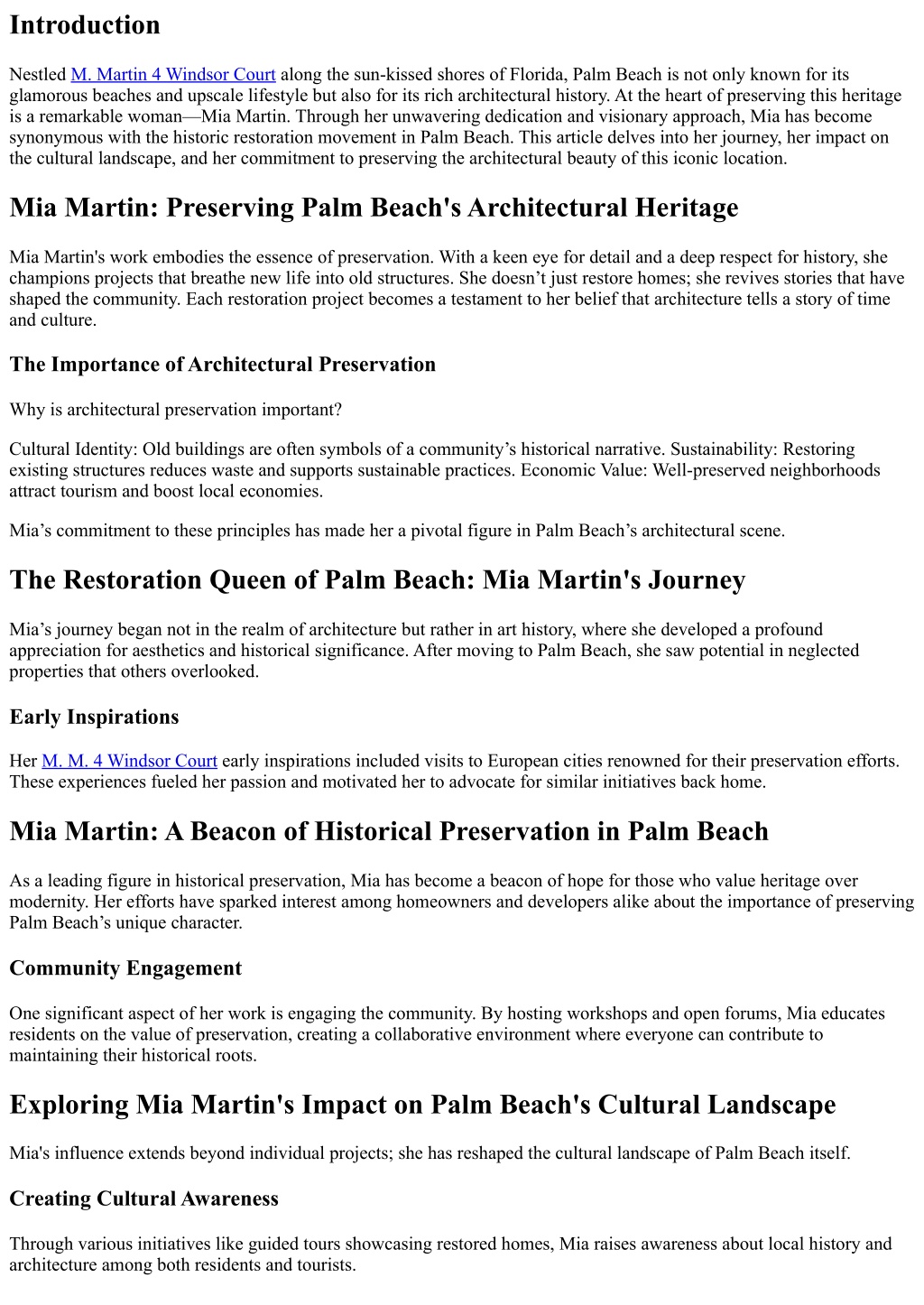Mia Martin Palm Beach Architecture And Heritage

The wrecking ball looms large over Palm Beach, Florida, a town synonymous with opulent estates and a meticulously preserved architectural heritage. A heated debate is raging: how to balance the allure of modernization and the demands of a wealthy clientele with the responsibility of safeguarding irreplaceable historical treasures.
At the heart of this controversy stands Mia Martin, a name now inextricably linked to the future of Palm Beach's architectural legacy. This article delves into Martin's vision, the challenges she faces, and the broader implications of her work for the town's identity. We will explore the tensions between progress and preservation, the voices championing each side, and the potential consequences for this iconic community.
The Legacy Under Threat
Palm Beach's architectural landscape is a tapestry woven from the threads of renowned architects like Addison Mizner, John Volk, and Maurice Fatio. Their Mediterranean Revival, Art Deco, and Regency-style masterpieces define the town's unique character. These estates, often passed down through generations, are now facing unprecedented pressure for redevelopment.
Rising property values and a desire for modern amenities are driving a surge in teardowns and renovations. Many argue that these changes are eroding the town's historical fabric, replacing irreplaceable landmarks with contemporary structures that lack the charm and authenticity of the originals. The Palm Beach Preservation Foundation estimates that at least a dozen significant historical properties have been demolished or substantially altered in the past five years alone.
Mia Martin: Guardian or Gatekeeper?
Mia Martin, a seasoned architect and historic preservationist, serves as the chair of the Palm Beach Architectural Review Commission (ARC). The ARC plays a critical role in regulating development and ensuring that new construction and renovations are compatible with the town's architectural character. Martin's appointment has been met with both praise and criticism.
Supporters hail her as a staunch defender of Palm Beach's heritage, a tireless advocate for responsible development, and a champion of preserving the town's unique identity. They believe that her expertise and unwavering commitment are essential to protecting Palm Beach from irreversible damage. "Mia understands the soul of Palm Beach," says local historian Jane Thompson. "She is dedicated to ensuring that future generations can appreciate the beauty and history of our town."
Critics, on the other hand, accuse her of being overly restrictive and stifling innovation. They argue that the ARC's regulations are cumbersome and outdated, hindering economic growth and preventing homeowners from modernizing their properties to meet contemporary needs. Some developers have accused Martin of wielding too much power, leading to project delays and increased costs. “She is trying to freeze Palm Beach in time,” claims real estate developer Robert Davis. “We need to embrace progress, not cling to the past."
The Architectural Review Commission: A Balancing Act
The ARC's mandate is to review all proposed construction and renovation projects in Palm Beach. The commission assesses projects against a set of guidelines that emphasize architectural compatibility, historical accuracy, and preservation of significant features. The process can be lengthy and complex, often requiring multiple revisions and approvals.
The guidelines themselves are subject to interpretation, leading to disagreements between the ARC and property owners. The debate often centers on the definition of "architectural compatibility." What constitutes a sympathetic addition to a historic building? How far can a renovation deviate from the original design without compromising its historical integrity?
Martin emphasizes that the ARC strives to find a balance between preservation and progress. "We are not against change," she explains. "We simply want to ensure that new development is sensitive to the town's architectural character and that significant historical features are preserved." She points to several successful projects where the ARC worked collaboratively with developers to achieve both modernization and preservation.
The Economic Impact of Preservation
The debate over Palm Beach's architectural heritage also has significant economic implications. Some argue that strict preservation regulations can deter investment and limit property values. Others maintain that the town's unique architectural character is a major draw for tourists and wealthy residents, contributing to its economic vitality.
A recent study by the National Trust for Historic Preservation found that historic districts often experience higher property values and increased tourism revenue compared to non-historic areas. The study suggests that preserving architectural heritage can be a powerful economic driver, attracting investment and creating jobs. However, these findings are disputed by some economists who argue that the benefits of preservation are often overstated.
The Future of Palm Beach: A Crossroads
Palm Beach stands at a crossroads. The decisions made in the coming years will determine whether the town retains its unique architectural character or succumbs to the pressures of modernization. The role of Mia Martin and the Architectural Review Commission will be crucial in shaping this outcome.
The challenge lies in finding a way to balance the needs of the present with the responsibility of preserving the past. This requires open dialogue, collaboration between stakeholders, and a willingness to compromise. The future of Palm Beach depends on its ability to navigate these complex issues and create a sustainable vision for its architectural heritage. This is not simply about buildings; it is about preserving the soul of a community.
"We must remember that these buildings are not just bricks and mortar," says Martin. "They are tangible links to our past, reminders of the people who came before us, and a source of inspiration for future generations."


















